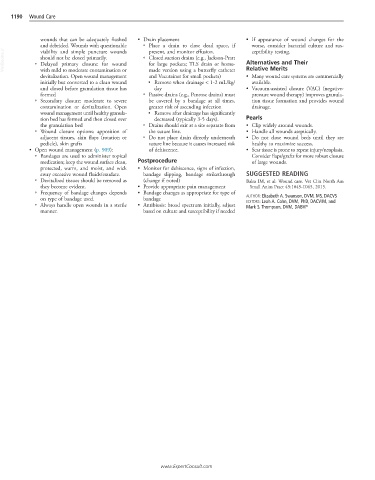Page 2406 - Cote clinical veterinary advisor dogs and cats 4th
P. 2406
1190 Wound Care
wounds that can be adequately flushed • Drain placement • If appearance of wound changes for the
and debrided. Wounds with questionable ○ Place a drain to close dead space, if worse, consider bacterial culture and sus-
VetBooks.ir ○ Delayed primary closure: for wound ○ Closed suction drains (e.g., Jackson-Pratt Alternatives and Their
present, and monitor effusion.
viability and simple puncture wounds
ceptibility testing.
should not be closed primarily.
for large pockets; TLS drain or home-
Relative Merits
with mild to moderate contamination or
and Vacutainer for small pockets)
devitalization. Open wound management made version using a butterfly catheter • Many wound care systems are commercially
initially but converted to a clean wound ■ Remove when drainage < 1-2 mL/kg/ available.
and closed before granulation tissue has day • Vacuum-assisted closure (VAC) (negative-
formed ○ Passive drains (e.g., Penrose drains) must pressure wound therapy) improves granula-
○ Secondary closure: moderate to severe be covered by a bandage at all times, tion tissue formation and provides wound
contamination or devitalization. Open greater risk of ascending infection drainage.
wound management until healthy granula- ■ Remove after drainage has significantly
tion bed has formed and then closed over decreased (typically 3-5 days). Pearls
the granulation bed ○ Drains should exit at a site separate from • Clip widely around wounds.
○ Wound closure options: apposition of the suture line. • Handle all wounds aseptically.
adjacent tissues, skin flaps (rotation or ○ Do not place drain directly underneath • Do not close wound beds until they are
pedicle), skin grafts suture line because it causes increased risk healthy to maximize success.
• Open wound management (p. 909): of dehiscence. • Scar tissue is prone to repeat injury/neoplasia.
○ Bandages are used to administer topical Consider flaps/grafts for more robust closure
medication; keep the wound surface clean, Postprocedure of large wounds.
protected, warm, and moist, and wick • Monitor for dehiscence, signs of infection,
away excessive wound fluids/exudate. bandage slipping, bandage strikethrough SUGGESTED READING
○ Devitalized tissues should be removed as (change if noted) Balsa IM, et al: Wound care. Vet Clin North Am
they become evident. • Provide appropriate pain management Small Anim Pract 45:1049-1065, 2015.
○ Frequency of bandage changes depends • Bandage changes as appropriate for type of
on type of bandage used. bandage AUTHOR: Elizabeth A. Swanson, DVM, MS, DACVS
○ Always handle open wounds in a sterile • Antibiosis: broad spectrum initially, adjust EDITORS: Leah A. Cohn, DVM, PhD, DACVIM, and
Mark S. Thompson, DVM, DABVP
manner. based on culture and susceptibility if needed
www.ExpertConsult.com

